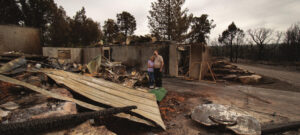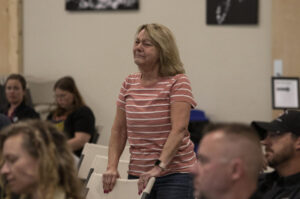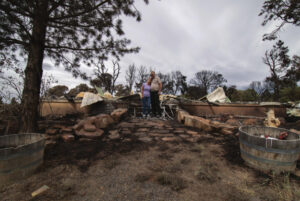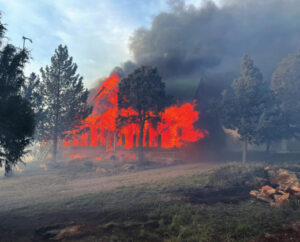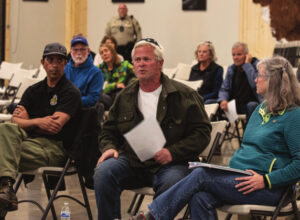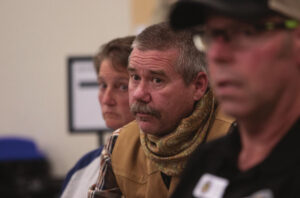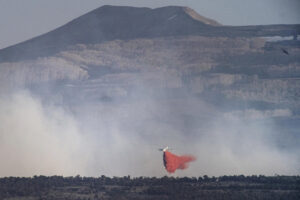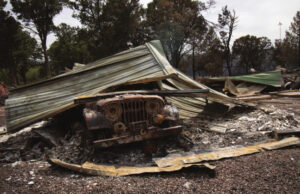The last straw for Amy Stauffer was having to euthanize her cat.
Three-year-old Poppy had somehow survived, hiding under a tree branch on the ground, two days after the fire burned down their house. It had snowed since then, helping to extinguish the flames and blanketing the charcoaled tree skeletons.
They found Poppy hiding. She was badly burned, and with no fur left to protect her, she had been shivering in the snow. Her eyes and paws were burned, but she was still alive, somehow.
The veterinarian told her it would require many surgeries and a long, painful recovery if Poppy lived.
“You’d have to take her home and watch her,” Amy remembers the vet saying. “And I said, ‘I don’t have a home.'”
The same afternoon she decided to put her cat out of her misery, Amy sat quietly, listening to the fire officials talk about containment, watched them point at maps and talk about the response to the blaze, about how they were able to evacuate people quickly. She listened to them talk about cutting down trees to help protect houses. She bounced her knee anxiously, becoming more irritated as the meeting progressed. Her husband Rudy patted her leg, attempting to comfort her, but she’d had enough. After listening for 30 minutes, she raised her hand and spoke.
“I want to know why you started that fire and burned up there,” she sobbed. “Now you have all these people doing stuff up there and it’s too late. And I don’t understand. I want you to explain it because everything I own is gone.”
Though the Stauffers were escorted into a separate room to meet with a Forest Service representative, their neighbors continued to voice their own concerns about the fire, suspected to have started with a prescribed burn.
A federal moratorium on prescribed fires, put in place a day after the 313-acre Simms Fire erupted, does little to comfort the Stauffers and their neighbors now.
Prescribed fire, meant to reduce the risk of catastrophic wildfires, has come under scrutiny after incidents where the very tool meant to solve a problem has gone awry. Fighting fire with fire to reduce fuel loads and manage landscapes is now under review, after a U.S. Forest Service prescribed burn raged out of control earlier this month in New Mexico and the Calf Canyon Fire became the state’s largest wildfire in history.
Members of the community around Wildcat Canyon are demanding answers about why the prescribed fire was set, how it became out of control and what the government is going to do to help those who were damaged by it and make sure it doesn’t happen again.
“They need to understand they’re messing with people’s lives,” Amy said.
Residents in the area of Wildcat Canyon and Government Springs Road knew there was a prescribed burn scheduled for the week of May 16. They watched the smoke rise, and kept an eye on it as the winds started to pick up on Wednesday night.
A sign on the highway told passersby not to call 911 – a prescribed burn was responsible for the smoke.
But on the afternoon of May 19, Rudy and Amy Stauffer saw 100-foot-tall flames coming their direction, and quickly realized this wasn’t a fire they could fight. Even though they’re both volunteers for the Horsefly Volunteer Fire Protection and they had a truck with firefighting equipment and a full water tank, it was hopeless.
Instead, they found themselves throwing valuables into a concrete room in their basement, hoping they would withstand the heat of the fire that would engulf their home. A neighbor helped Rudy ferry their vehicles away from the property. He moved the truck with the water tank to the fire department parking lot.
They took their dogs and drove away, just as the fire reached their driveway.
“We came out of the garage and the fire was there,” Rudy said. “It was burning our faces. We had to leave.”
A week after their home burned down, they still can’t believe this happened. They’re staying at their pastor’s home, grateful to be alive, but as the shock wears off, anger replaces it. They just do not understand how this could have happened.
The Forest Service officials who gave final approval for the prescribed burn – Ouray District Ranger Dana Gardunio and Fire Staff Officer Sean Stafford – told community members they followed the burn plan that was approved. These burn plans, which take years to come together and sometimes sit waiting for an opportune window where the conditions are just right for even longer, include exhaustive requirements for measuring fuels moisture and formulas for determining whether they can start the fire. Previous mitigation projects in the area helped crews gain control of the fire, particularly a mechanical fuels treatment conducted by the Bureau of Land Management in 2003, according to fire managers.
Though some fire crews camp out with prescribed burns, those tend to be in more remote areas and they camp at the fire for logistical reasons, Stafford told the Plaindealer. He said there was not a requirement in the plan or the agency’s policies requiring anyone to monitor the fire continuously.
Stafford told the crowd the fire took off only about 30 minutes after the patrol left on Thursday. The Stauffers still can’t understand why the fire was left without someone to monitor it, and how that could be an acceptable practice.
“I think the biggest thing that went wrong was them leaving the fire,” Rudy said.
The Stauffers and other neighbors said they want the federal agency to take responsibility for the fire, and they criticized the Forest Service’s response at the community meeting, which they considered tone-deaf.
“To hear them patting themselves on the back up there, that rubbed a raw edge,” Rudy said.
Others agreed.
“Nobody wants to take responsibility for it,” said Kendra Jenkins, whose property was adjacent to Forest Service land and was damaged, along with two RVs.
“Who lit the match?” demanded her husband, Mike Jenkins. It was a demand others made later in the meeting, as the crowd became more agitated.
“If that was me that did that, I’d be in jail right now,” said resident James Davis.
“Accept responsibility and tell people, sorry that we did this,” said Bob Winter, who had to evacuate from his home on Happy Canyon Road.
On Saturday during the community meeting, Gardunio initially praised the response to the fire and called it seamless, before neighbors confronted her.
“We did receive a phone report late on Thursday afternoon, and had multiple resources that responded immediately. It was pretty amazing, the response time and how quickly not just our forest service personnel but local fire departments (responded),” she said.
“That interagency coordination was really seamless, which was fantastic to see,” Gardunio said. She later apologized to the angry crowd.
“It was my decision. I made that decision based on the best information I had at the moment,” she said. “My heart goes out to all of you and I’m very sorry.” She also apologized tearfully to the Stauffers, after the community meeting ended.
The neighbors of the fire said they had serious concerns about the way the fire was handled, and that they didn’t believe their calls reporting the fire were taken seriously.
Those calls were made hours before the Forest Service said the fire was reported, according to some neighbors. One neighbor said she argued with a dispatcher over what she was seeing with her own eyes, begging for help.
Now, neighbors of the Simms Fire want to know why the fire was set in the first place, why it wasn’t being monitored continuously, why it was left on Thursday afternoon after a patrol. And they want to know why some of their calls for help were dismissed.
Nancy Davis called for the first time about the fire at 2:36 p.m. Thursday.
A former fire dispatcher in Southern California, she knew immediately that the smoke and ashes she saw blowing outside her window weren’t just remnants of the Forest Service’s controlled burn.
She called the headquarters for the Grand Mesa, Uncompahgre and Gunnison National Forests, but got a voicemail message, she said. Then, she dialed the Montrose Interagency Dispatch, where she knew she could reach someone responsible for the Forest Service and Bureau of Land Management.
It was nothing, she said she was told. Ash was normal, the dispatcher told her, and the crew had just gotten back into town from patrolling the site. Davis was surprised to hear they’d left, instead of staying to monitor the burn, but the dispatcher dismissed her concerns.
But as she continued to watch from her home on Government Springs Road, she only became more sure of what she was seeing. “This thing is taking off,” she thought, and at 3:05 p.m., she dialed the number again.
She was brushed aside a second time, told she was probably seeing stumps burning. When she insisted it was an active fire, she was put on hold, then transferred to a “burn boss,” only to be told again she was wrong.
“I said no, this is an active fire, you’ve got smoke, you’re going to lose this thing, it’s going to blow up,” Davis said. “They’re blowing me off, big time.”
More calls followed — to Horsefly Volunteer Fire Protection Chief Larry Behrends, and then to her husband, Bob. She started preparing to evacuate, and kept her eye on the smoke outside. About an hour after her first report, she called 911.
This is a rekindle of the Simms Mesa prescribed burn, she told the Western Colorado Regional Dispatch Center. “You need to dispatch the Horsefly Volunteer Fire Department and everything,” Davis said. She was told the Forest Service needed to be contacted, and when she insisted again, the call ended. “He said, ‘We will dispatch according to our protocol, thank you very much,’ and hung up on me,” Davis said.
By the time the first fire engine arrived, Davis had watched the fire make its way almost to the road, and the evacuation order for homes within a five-mile radius didn’t arrive until 5:10 p.m. She and Bob, who returned home, had already started preparing to leave, loading up their 14 dogs and trying to round up their four cats.
“They could have saved the houses, had they dispatched the very first time it was called in at 2:38,” Davis said. She’d learned as a fire dispatcher that anytime there was high wind and a report of smoke, “you sent a whole wildland response, because it’s better to have them and not need them than need them and not have them.”
“We called for help, and they ignored it,” Bob Davis said.
A half mile away on Wildcat Canyon Road, Dave Monson was making phone calls of his own.
When the controlled burn started earlier in the week, he couldn’t understand why.
“There’s plenty of people that knew the weather forecast said Thursday was going to be very windy,” he said. “That’s one of the big questions: How could they have done this, knowing the weather?”
When the winds picked up Thursday, as the forecasts had predicted, he saw increasing smoke from the burn area.
He called dispatch twice on Thursday, and said he wasn’t taken seriously.
“I needed answers. What’s the plan here, folks? This is growing,” Monson said. “I thought they would tell us more than that, reassure us with something substantive.”
Their son, Jace, also called dispatchers for help, and he started calling Wednesday night at 7:58 p.m. “You could see open flame and smoke,” he said. He called three more times on Thursday.
By the time someone from the Ouray County Sheriff’s Office arrived to notify them, the Monsons were still deciding whether to evacuate. Dave Monson said he wasn’t told it was mandatory, and he was wary of leaving behind his home when he didn’t trust the people protecting it.
“Frankly, I wasn’t sure of the competency of anybody at that point to come in and save our house,” he said. The home has a perimeter around it, and they decided to stay as long as possible.
When they ultimately left, they made their way down Government Springs Road. Later that night, they returned, afraid they wouldn’t be able to get back in for days if they waited longer. From inside the house, he watched the fire all night, and around 3 a.m., when fire appeared to be heading toward the home, they almost fled again.
“I thought maybe we better get out of here,” he said. “This huge, orange ball of fire was going up and getting closer,” he said.
“That can drop you to your knees,” he said, and they began to pray. Shortly before they were about to leave again, the wind shifted and spared the house. He could see the stars again, a sign the smoke was blowing in a different direction.
“If it had shifted west, we would have been in big trouble,” he said.
There were actually two planned prescribed burns in the area – a 100-acre prescribed burn by the Bureau of Land Management and the 200-acre prescribed burn by the Forest Service.
It’s not clear why the BLM canceled their fire but the Forest Service proceeded, even though the prescribed burns were planned within just a few miles of each other. The BLM had planned earlier to set its burn on May 5, but then postponed it due to dry weather conditions. At the time, the agency said it would try to find another time to burn it before May 15, when a mandatory wildlife closure for migratory birds went into effect for the area, enacted due to the Migratory Bird Treaty Act of 1918, according to the BLM. This treaty prevents the “take” of protected migratory birds, and includes closures for certain areas during migration and nesting periods.
Stafford said the rule didn’t apply to the Forest Service’s burn, but it’s still not clear why the treaty rules would apply to one federal agency and not another in the same area. The Forest Service lit its prescribed burn on May 16, a day after the BLM’s wildlife closure went into effect.
There are still more questions than answers about exactly how the Simms Fire happened and what could have been done differently. It’s not clear when an investigation will be finished, but Forest Service officials have told the Wildcat Canyon neighbors they are expediting it.
Property owners are concerned they won’t be able to get any restitution without a definite finding that the Forest Service’s prescribed burn was the cause of the fire. They worry a slow, bureaucratic process of review may prevent them from getting the help they need, quickly.
And for people like the Stauffers, they’re left in a limbo of insurance, paperwork and uncertainty.
The residents want answers, accountability and apologies.
“Who in authority gave the green light to go ahead with these high wind warnings?” Monson said.
Neighbors said they hope lessons can be learned from a thorough review.
“They need to learn,” Nancy Davis said, to have a better perimeter in place and to not burn unless the conditions are right, following the same rules that residents have to follow on red flag days and when high winds are expected. “You’re telling the homeowners they can’t burn, and you’re going to turn around and burn? That makes absolutely no sense,” she said.
Like Monson, the Davises want the people who started the fire to own up to it.
“The bottom line is, the Forest Service are arsonists,” Bob Davis said. “They’re the ones that burned Amy’s house down.”
They knew living by the forest had its dangers, but they weren’t prepared for this scenario, Nancy Davis said.
“We choose to live in that area, we know the risks involved, but we never thought the government would try to burn us out.”

